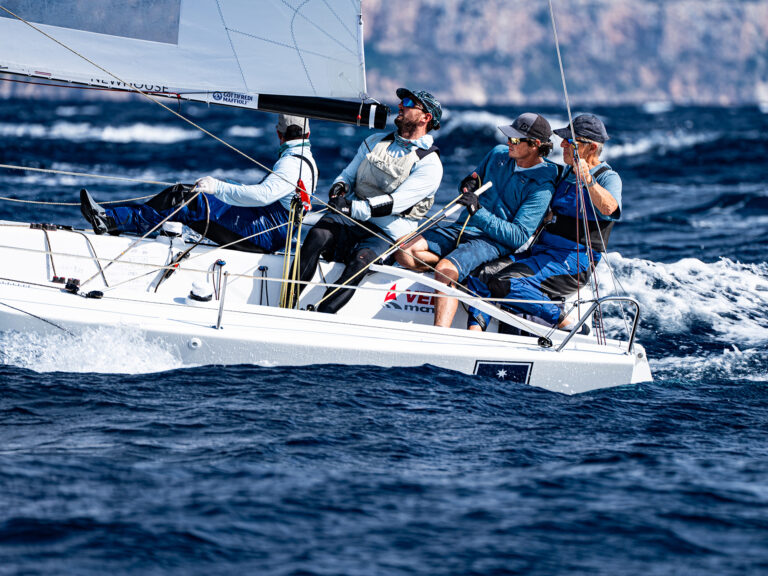
MarJobsonSt
Georgetown and Tufts are fighting it out with two legs to go. The Inter-Collegiate Sailing Association Team Racing Championship is on the line. I’m standing next to St. Mary’s coach Adam Werblow, giving a play-by-play commentary to Tufts coach Ken Legler, at home on sick leave. The lead in the three-on-three race changes quickly. Georgetown’s All-American Andrew Campbell snares two Tuft boats, springing his teammates into the lead with only 100 yards to go. There’s a frenzy of maneuvering between all six boats, and in a flash, it’s over. Georgetown wins. This is exciting to watch-far better than any match racing or fleet racing I’ve seen. It deserves Olympic status.Over the past 20 years, participation in team racing has grown dramatically. Teamwork, advanced tactics, quick boathandling, and lots of team spirit and rivalries are its fundamental elements. Team racing was once mainly a scholastic phenomenon, but club-level and post-college team racing is growing a wide base worldwide.”Time-efficient competition gets people on the water,” says New York YC team race committee chairman Chris Woods. “Short courses and inshore venues make for lots of racing for the precious time available. Equal boats, often club owned, take out the ‘arms race’ factor.”Former U.S. Naval Academy coach Gavin O’Hare, an authority on team racing and one of its biggest cheerleaders, adds that team racing is an excellent spectator sport. “The races are short, action packed, and populated by colorful boats and crews with outspoken personalities,” says O’Hare. “Team racing attracts adrenaline junkies.””Team racing multiplies the game factor into a fascinating puzzle of high-speed decision making,” says U.S. Olympic sailing coach Gary Bodie. Philosophically, team racing works, he adds, “because the growth is the result of an ‘ad hoc’ agreement among players that old-style, sleazy protesting is an absurd waste of time. Peer pressure is the glue that keeps sportsmanship in line. The challenge for team racing in the future is to maintain the same level of respect, trust, and sportsmanship, whether umpires are present or not.”I first wrote about team racing for this magazine back in 1975. At the time, there were very few team-race regattas. Today, there are many high-profile international events, including the ISAF World Championship, Wilson Trophy at West Kirby, England, the Hinman Trophy, and, of course, vast amounts of college team racing. Even Optimist sailors are embracing it, which bodes well for the discipline’s future. The Olympic Games are team racing’s next step.Gaining entry into the Olympics is a major challenge, however. The process starts with a proposal by a National Governing Body-in our case US SAILING. The International Sailing Federation would review the proposal and then pass it to various committees to review. If the proposal receives strong support, a recommendation is made to the International Olympic Committee.The IOC wants to include sports that are played by many people. Spectators and television producers like sports where medals are awarded after the final contest. By allowing throwout races, sailing fails this standard. Medals are often decided before the last race, deflating interest in the outcome. For 2008, the IOC has tried to improve the fleet race format by creating a top 10-boat finale. This may help, but a three-boat, sudden-death final, featuring sailors representing their country is much more enticing. With an elimination series, the winner of a team-race event would be decided in the final race.To save costs, the IOC is under pressure to reduce the number of athletes participating. Presently, sailing is allowed to host 400 athletes. ISAF breaks the competition into 11 classes. In Athens in 2004 this worked out to 256 boats. A three-boat doublehanded team would include six sailor athletes. The top eight teams (48 sailors) would qualify for the Games after a series of events run by ISAF. A round-robin series, at the Games, would establish seeding before an elimination series. ISAF would have to drop some classes to make this happen. But every class racing in the Olympics today is fleet racing, and team racing would provide a breath of fresh air.Currently, the 11 Olympic classes are broken down into four female, four male and three open classes (available to either male or female sailors). The team-race format could specify co-ed teams. Say, 50-percent male, 50-percent female, and at least one female should be a skipper.The IOC is also concerned with the cost of competing. The fleet of boats for a team-race discipline, preferably a fast sloop-rigged design, would have to be provided. The most popular racecourse for team racers today is configured as a “digital starboard N,” and its use would allow several flights to be run efficiently on the same racecourse.The team aspect is in line with many other popular sports. At the Olympic level, team sports that feature relay races, as well as basketball, and volleyball are popular. There is great potential here so long as team race organizers and participants clearly demonstrate the team component of this discipline. Coordinated boat and sail colors, uniforms, and spectator-friendly venues are essential for it to become accepted at the Olympic level.When asked whether team racing should be in the Games, Woods says, “Definitely. While the athlete limit is an issue, it is fun, easy to watch, and has a real team focus.”Past NYYC Commodore George Hinman observes, “Olympic sailing may die due to lack of excitement. Team racing is the most exciting closed-course racing.”Bodie likes the idea as well. “My dream would be three-versus-three team racing in 49ers,” he says. “Initially, it would all be about sailing the boats, but after the teams practiced for three years, it would be about team racing at high speed.”I have competed in and covered every level and format in sailing, and strongly feel that team racing offers the best potential because it brings out a higher competitive spirit, it’s spectator friendly, and the races are fascinating to watch. Team spirit builds camaraderie and international goodwill, and most importantly, it’s a lot of fun.









